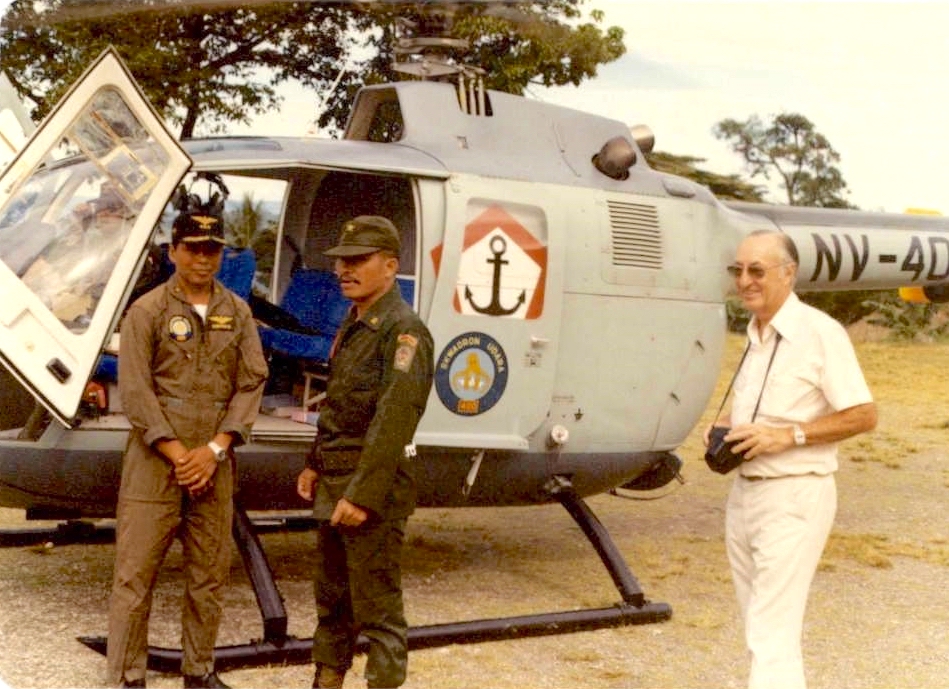The photographs show a smiling Australian, in short sleeves and cream-coloured slacks, with a camera slung around his neck, walking amongst wide-eyed children and villagers on a typical island in the tropics. Dozens of women, dancing and singing and dressed in traditional attire, are welcoming the man.
He walks amongst the children and villagers who, though obviously poor, seem clean and well-fed. He inspects a small covered food market that lays out some produce on neat tables. He looks over a farm irrigation project being built in the bed of a dry stream. He speaks with officials, seemingly keen to explain what he is seeing.
The only hint that this is not an elderly Australian tourist on an escorted holiday tour are the uniformed soldiers who accompany him on his walk. And the Indonesian military helicopter that has flown him in.
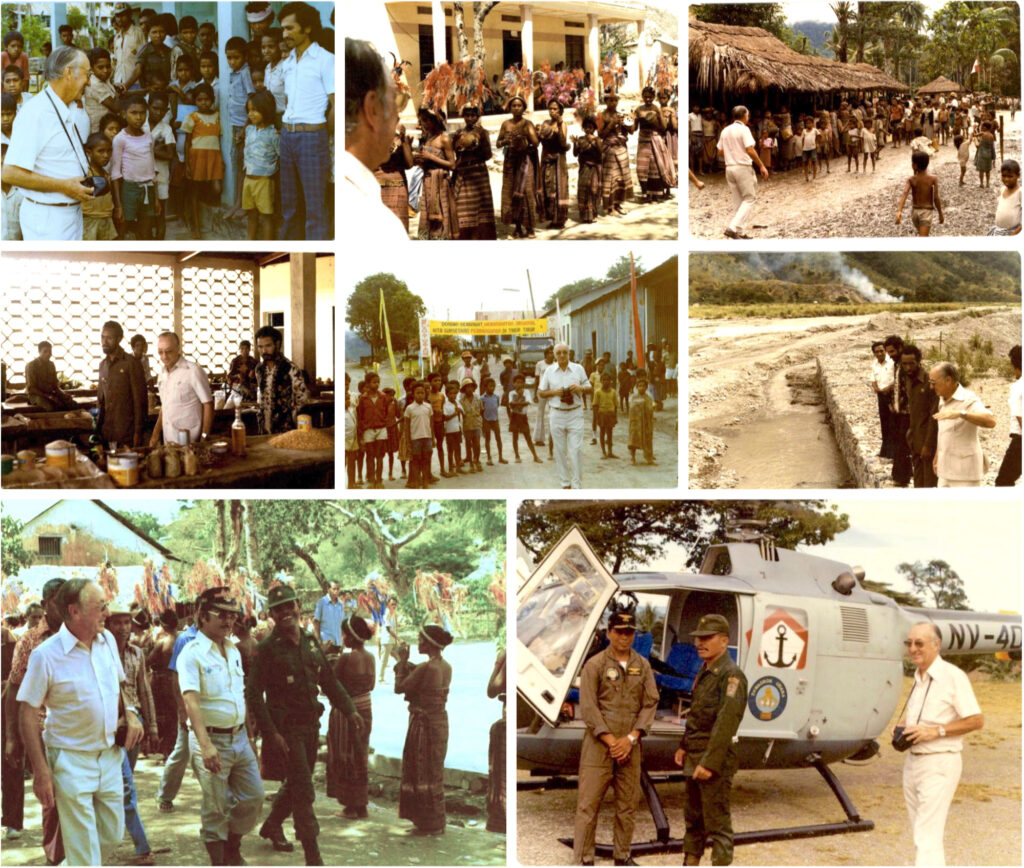
The photographs were not found in a faded old photo album on a shelf in the loungeroom of the man’s family home. They were found inside a folder marked ‘Secret‘ amongst Department of Foreign Affairs files that have been recently declassified and obtained from the National Archive of Australia.
In the Canberra archives, I was doing document research for my PhD, later published in my subsequent book, A Narrative of Denial: Australia and the Indonesian Violation of East Timor.
Taken during a visit to East Timor of the then Australian Ambassador to Indonesia Tom Critchley in May 1980, the photographs stand as a documentation of the attempts made by the Australian government and their Indonesian hosts to cover up crimes being committed on the Timorese people.
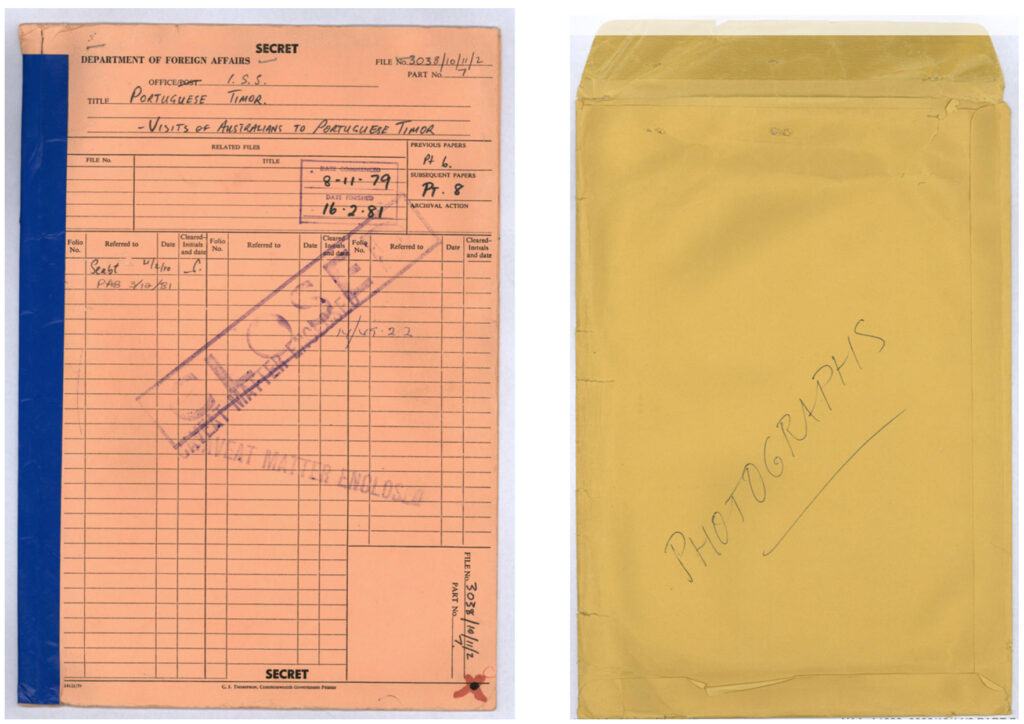
Contrary to the impression created by the photographs, the period of Ambassador Critchley’s visit was a dire time for the people of East Timor.
Just over four years previously, in 1975, Indonesia had invaded the small Portuguese island, with the full knowledge and approval of the West, equipped with some of the latest US weaponry. The invasion was accompanied from the first day by large scale death and destruction. The occupation of East Timor by the military government of General Suharto continued for the next 24 years.
East Timor’s Commission for Reception, Truth and Reconciliation (CAVR) has undertaken an extensive study of the Indonesian occupation period, and has documented arbitrary executions of civilians and mass killings in the days after the invasion.
Fretilin, the East Timorese independence front, fell back as the invasion continued. They withdrew to rural areas where, due to knowledge of the terrain and the self-sufficient nature of the rural economy, they were initially successful in holding off Indonesian forces and continuing a functioning society in much of the countryside.
The Indonesian military, aided by US and Australian supplied materiel and aircraft, launched a campaign to isolate and eliminate the Timorese resistance fighters. It was anticipated that the starving rural populations would abandon support for the guerrillas. In some ways the Indonesian campaign mirrored the US military campaign in South Vietnam a few years earlier, of ‘strategic hamlets’ and the ‘Phoenix Program’ to eliminate resistance guerrilla sympathisers.
This campaign of ‘encirclement and annihilation’ saw widespread destruction of food resources in Fretilin-held areas, enforced surrenders of the civilian population, and their relocation into transit and resettlement camps. Villages were bombed and destroyed, crops were burned, livestock destroyed. Napalm was used. Many civilians died during this campaign and in the aftermath journey to the camps.

The Indonesian military also perpetuated extensive human rights violations during this period, including massacres, murders, illegal detention, torture and sexual violence, documented in the thousands in the Chega! report by CAVR – ‘Chega’ being the Portuguese word meaning ‘Enough’ (CAVR, pp 218-9, 1747-9, 487-583).
Indonesian sources themselves estimate the number of people forced into resettlement camps by 1979 as around 300,000, out of a total population at the time of probably not much more than 700,000. The inability to tend to farms led to cataclysmic food shortages in the camps.
With a lack of food, proper shelter and medical support an artificial famine ensued, taking the lives of at least 80,000 and perhaps as many as 180,000 people. (CAVR, p 1338).
The Australian ambassador was visiting a country in turmoil and in great suffering. This, however, is not apparent in the affable nature of the photographs, nor in his secret report to the Australian Department of Foreign Affairs, now declassified by the National Archives of Australia.
Ambassador Tom Critchley was a career diplomat who had also served as High Commissioner to Malaysia and Papua New Guinea and Ambassador to Thailand. His commitment to Indonesian nationhood was forged by the significant role he played early in his Foreign Affairs career assisting Australia’s representation of Indonesia against the Dutch during the post-WW2 Indonesian independence revolution. He died in 2009.
In his reporting of the 1980 trip to East Timor, Critchley described what he saw as a well-meaning and responsible Indonesian administration attempting to bring a recalcitrant and backward people to heel under difficult circumstances not of its own making.
He commented on ‘the primitiveness of the people’, depicting the relocation of the population as a modernising measure to improve the quality of agriculture and access to resources. He remarked favourably on the general quality of the Indonesian military personnel and administrative staff.

This was not Ambassador Critchley’s first visit to East Timor, nor his first report. He previously visited the territory in September 1978 in a delegation of ambassadors from ten countries including the US, Canada and New Zealand. Critchley had that year replaced Richard Woolcott, who had been head of Public Affairs for the Department of Foreign Affairs before becoming Australian ambassador in the lead up to the invasion in 1975.
Most of the visiting ambassadors reported that they were appalled about what they saw. The US Ambassador reported that a group of 200 men, women and children that he saw were ‘emaciated and in a pitiful condition’. The Canadian ambassador described refugees as emaciated with only the rudiments of clothing, while the ambassador of Papua New Guinea told the media he had never seen people in such bad state. Most of the ambassadors termed it a major humanitarian problem and agreed that an international relief effort was required to prevent more large-scale death.
Ambassador Critchley, in contrast, was initially quoted in the Canberra Times on 10 September 1978 as saying he was impressed by the extent of development and progress made under Indonesian rule.

However, with the international media giving substantial coverage of the dire situation described by other ambassadors, the following day he cabled to Canberra recommendations as to how the humanitarian crisis could be spun to the public and the international community.
The files show Critchley’s approach was to blame the crisis not on the actions of the Indonesian invaders, but on the supposed fact that “the people of Timor have always been poor and most of them seem to have always lived just above the subsistence line”, made worse by a civil war and the irresponsible actions of the Timorese themselves. Critchley advised the Department that any reference to the poor condition of the Timorese should state the Indonesian contention that ‘the problem is not, repeat not, of Indonesian making’. (DFA 1978a)

The Timorese themselves should instead be blamed for the fighting, and the Indonesians commended for their attempts to deal with large numbers of people leaving Fretilin-controlled areas suffering from malnutrition and disease:
‘The Indonesian government is concerned to normalise the situation as quickly as possible and wishes to avoid a situation where large number of people become permanently dependent on relief. The policy, therefore, is to keep people in the camps for up to three months and then return them to their original homes so they can start producing. While in the camp they are given food, clothing and medical attention, as well as being taught some basic skill that will help them rehabilitate their homes and farms.’
Critchley’s narrative was a fantasy, a propaganda story constructed to cover a crime. The Timorese traditional agricultural economy had in the past been self-sufficient and successful in feeding the population. The famine was an artificial one deliberately enacted by the Indonesian military in its attempt to subdue resistance.
The camps were semi-permanent, part of the Indonesian strategy of destroying rural society and isolating the people from the Fretilin fighters. The conditions in them were appalling, with poor hygiene, widespread starvation, a very high death rate, and with people in them prevented from leaving.
Ambassador Critchley’s assessment was even contradicted by a major Australian intelligence agency. A letter from the Defence Department to the Department of Foreign Affairs (DFA) Secretary affirmed the probability of a very high death rate, citing a highly reliable intelligence report by the Australian Joint Intelligence Organisation (JIO, since renamed the Defence Intelligence Agency, DIO).
The Defence report criticised the country report by the Ambassador:
‘The information provided to Mr Critchley concerning the military/security situation is considered misleading, and in line with consistent Indonesian attempts to present an appearance of increasing normality to visitors.’ (DFA 1978c).
Nevertheless, the Australian Liberal-National Country Party coalition government of prime minister Malcolm Fraser (1975-1983) quickly adopted Critchley’s recommendations for its propaganda offensive in defence of the Indonesian regime.
Declassified Australia has previously reported the presence of a secret Department of Foreign Affairs propaganda unit first established in 1971 to disseminate positive stories to the news media, particularly focussed on East Timor. The propaganda unit was located within the department’s Public Affairs division then headed by Richard Woolcott.
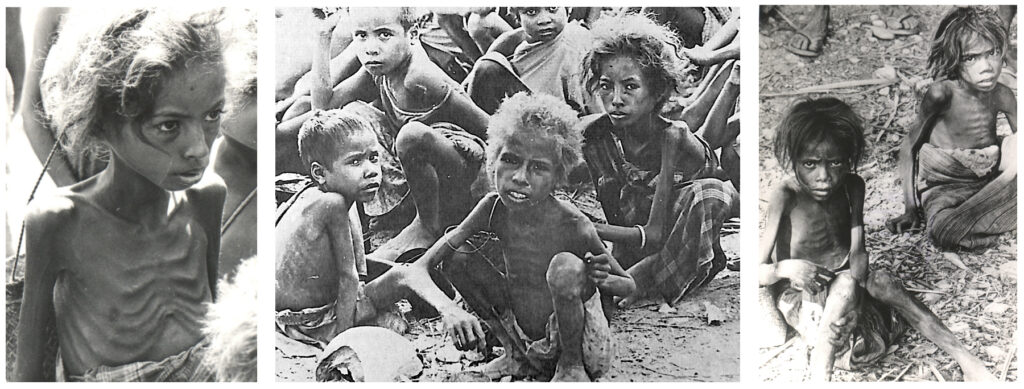
The Foreign Minister, Andrew Peacock, issued a media release emphasising that the ‘very poor’ subsistence conditions had been worsened by Timorese irresponsibility, and depicting a caring responsible Indonesian administration dealing as best it could with a situation not of its making.
Peacock reiterated this position in the House of Representatives, as did his representative Senator John Carrick in the Senate. More importantly, Australian government representatives propagated this disinformation in the international arena, in its country-to-country lobbying on behalf of the Suharto regime, and in its attempt to stifle international concern, head off calls for inquiries and remove the Timor issue from the agenda of the United Nations.
The reports by Critchley from both his 1978 and 1980 visits served as vehicles of denial and apologetics, constructing an artificial reality far removed from the catastrophe unfolding in East Timor at the time. In both, Critchley dismissed accusations of atrocities and presented the Indonesians as benevolently doing their best to help the ‘backward’ East Timorese.
Following his 1978 visit, Critchley denied the nature of the camps, approvingly citing the Indonesian assertion that, ‘there are no detention camps as the policy is to resettle people in their homes as quickly as possible’. He claimed that Indonesian policy was to give ‘lenient treatment’ to Fretilin fighters who gave up, while in fact the CAVR commission demonstrates that fighters who gave up were frequently tortured and murdered (DFA 1978b).
By the end of 1979, the famine could no longer be covered up, as for two years reports of the famine had been leaking out from aid and church groups, and from journalists and other observers. The truth was finally conceded, at least in part, in November when front pages of Australian newspapers flashed photos of the catastrophe.

The report served to frame the East Timor famine as a ‘natural disaster’, supporting the narrative of denial of Indonesian crimes. But by this time most of the Indonesian campaign of ‘encirclement and annihilation’ had been allowed to play out under Australian cover.
The article quoted an official saying the famine should not be seen as ‘deliberate intent on Indonesia’s part’. ‘I have seen nothing’ that would confirm allegations of genocide, he told the journalist. The photographs were taken by a former Jakarta Embassy first secretary in political affairs, Peter Rodgers, by then a newly-minted Jakarta-based journalist for the Sydney Morning Herald, but soon to return to the Department of Foreign Affairs.
The motive for the 1980 visit, as made clear by the archives, was not so much a desire for information about the territory in itself, but to make it possible to counter criticism of Indonesia and claims of atrocities from first-hand experience.
With complete denial of forced resettlement no longer feasible by that time, Critchley resorted, in the face of media criticism, to calling it a ‘tribal relocation program’ aimed to curb ‘the destructive habits of the migratory tribes and improve the miserable living conditions in which so many of the East Timorese have been living for centuries’.

Remarking on the supposed ‘primitiveness of the people’, he claimed that, ‘the bulk of the population will clearly accept whatever authority exists at the time’, an assertion in contradiction to the ongoing Timorese armed and diplomatic resistance to the occupation.

Throughout his Ambassadorship, Critchley worked stridently to provide ammunition to the Australian government for the purpose of undermining critics of the occupation and deflecting international concern about the situation in the territory. In this regard he was far from alone.
Under both Labor and the Liberal-National Country Party coalition, Australian governments regarded support for General Suharto’s pro-Western regime as vital to their regional security strategy, to strengthening relations with the anti-communist ASEAN nations, and also to opening Indonesia’s vast resources to Western companies.
In 1965/67 the Suharto regime had ousted the first President of Indonesia, Sukarno, and engaged in an extensive and bloody purge of the Indonesian Communist Party, killing upwards of 500,000 people. In an atmosphere of Cold War paranoia, the Australian government welcomed this development, and the militaristic and oppressive, but anti-communist and pro-western, New Order that emerged under Suharto.
The Australian government under Labor Prime Minister Whitlam (1972-75) had judged incorporation of East Timor into Indonesia as desirable, actively encouraging an Indonesian intervention before the invasion. The issue of Timor Sea resources added a further impetus to this position.
After the invasion, the Fraser government (1975-81) proactively worked on behalf of the Suharto regime in the international arena, lobbying a range of countries, from Guatemala to Brazil to the Solomon Islands to Sweden amongst others. These efforts were denying evidence of abuses, belittling those who claimed otherwise, propagating a false narrative, heading off calls for international enquiries, and attempting to remove the issue from the United Nations agenda.
Australia also provided extensive military aid and equipment to Indonesia during the most violent early years of the occupation, including eighteen Australian-made Nomad Searchmaster reconnaissance aircraft, sixteen Sabre jet fighters, twelve Sioux helicopters, eight patrol boats, 250 military Landrovers, and a range of other military materiel. The Nomads were mainly for reconnaissance, but they were built with four hardpoints, each able to take 500lbs of weapons including gun pods and rockets.
While ambassador Critchley was travelling in East Timor, Australian military equipment such as the Australian-built Nomad Searchmaster military aircraft were being used by the Indonesian military including in East Timor. Despite a condition to the contrary placed on the transfer, documentation found in my archival research proves that the Australian Nomad aircraft were used by the military in East Timor. An Australian official reporting back to Canberra, noted an Indonesian Navy Nomad parked on Comoro Airfield near Dili during a visit in January 1979.
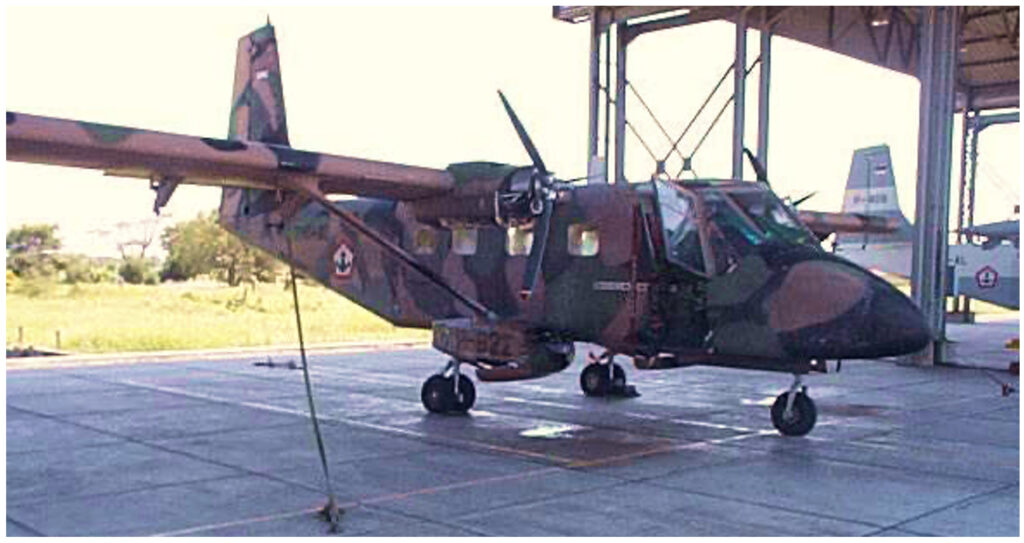
Despite being ably assisted into independence by the Australian military deployment leading the praiseworthy 1999 INTERFET intervention after the independence vote, Australian deceit, of course, did not finish with the end of the occupation and East Timorese independence in 2002.
The Australian spying on the East Timorese Cabinet room in 2004 led to the Australians negotiating a blatantly inequitable Maritime Agreement dividing the resources on the Timor Sea. Following the exposure of the spying, a new fairer treaty was negotiated and finally signed in 2018. However the revenue from the gas taken from under the seabed now in East Timor’s area, remains firmly in non-Timorese pockets. This effective confiscation by Australia of oil and gas revenues that should have gone to the Timorese people remains an ongoing injustice and stain on the Australian nation.
Australia’s role during the Indonesian occupation itself is largely considered as one of passive acceptance, a ‘blind eye’ to events to which it fails to respond. In fact, as these documents and files clearly show, Australia played a very active role, encouraging the Indonesian intervention before it took place, and acting as the Suharto regime’s key propagandist in the international arena while the worst of the atrocities were occurring.
Australian lobbing not only delayed a resolution of the East Timor independence issue, but also curtailed measures to highlight and alleviate the suffering, actions that undoubtedly cost many, many lives.
The active role that Australia took in supporting the attempted genocide of the Timorese people is still obscure to much of the Australian public. No true reconciliation nor compensation to the East Timorese nation is likely without a true appraisal of the unredacted facts.
—
References:
CAVR (Comissão de Acolhimento, Verdade, e Reconciliac̦ão Timor Leste). Chega!, Dili: CAVR, 2013.
DFA 1978a. NAA: A1839, 3038/10/11/2, v. Cable from Jakarta to Canberra. Humanitarian Assistance to East Timor. Critchley. 11 September 1978.
DFA 1978b. NAA: A1838, 3028/10/11/2, v. Cable from Jakarta to Canberra. Visit to East Timor. Critchley. 14 September 1978.
DFA 1978c. NAA: A1839, 3038/10/11/2, v. Letter from DG Coley [?] for First Assistant Secretary, Strategic and International Policy Division, Department of Defence, to the Secretary, DFA. 13 October 1978.
DFA 1979. NAA: A10463, 801/13/11/1, xxxi. Visit to East Timor. G. Allen. Undated, probably February 1979.
DFA 1980a. NAA: A1838, 3038/10/11/2 vii. Cable from Jakarta to Canberra. Visit to East Timor. Secret. Critchley. 4 June 1980.
DFA 1980b. NAA: A1838, 3038/10/11/2 vii. Cable from Jakarta to Canberra. Ambassador’s visit to East Timor, 19-23 1980. 9 June 1980.
DFA 1980c. NAA: A1838, 3038/10/11/2 vii. Cable from Jakarta to Canberra. Media coverage of Reports on East Timor.25 November 1980.
DFA 1980d. NAA: A10463, 801/13//11/1 xxxi. Letter from Hogue to Critchley. 17 December 1979.
—
*Additional research by Peter Cronau.
